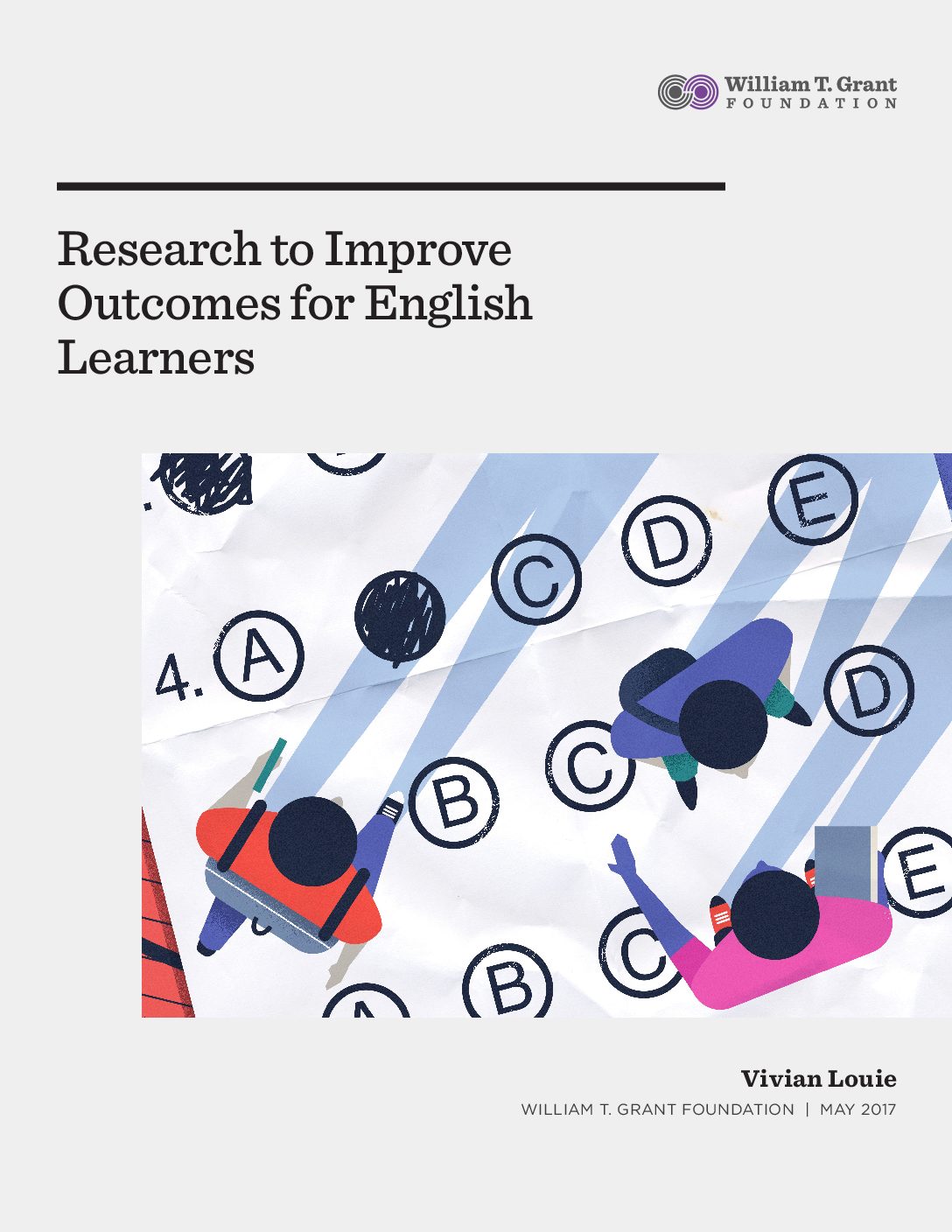The English learner (EL) population constitutes ten percent of all PK-12 students in the United States and is a critical segment of immigrant-origin youth. While ELs have the advantage of speaking a language other than English at home, they also need additional supports in order to help them master core content taught in English as they transition into schools.1
The Every Student Succeeds Act (ESSA) presents a unique opportunity to improve outcomes among English learner students.2 ESSA foregrounds EL students in our K-12 state accountability systems in three key ways. First, English language proficiency is now included in accountability under Title I. This is significant, as the Title I program provides supplementary federal funds to local educational agencies and schools with large percentages of low-income students as a strategy to improve their academic outcomes. Under ESSA, Title I schools continue to be held accountable for showing progress in the reading and math achievement and graduation rates of all their students, including ELs. The key shift is that ESSA requires states also to include English language proficiency in Title I, moving it from Title III, which covered only ELs and was seen as a separate and secondary accountability mechanism. With the shift to Title I, standards and assessment for English language proficiency are placed at the forefront of states’ accountability plans, on par with academic standards and their assessment. Under ESSA, schools now have to report on and show progress in the English language proficiency of their EL students. The driving premise is that this information will help schools provide services that will improve EL academic achievement.
By moving accountability systems from the federal to the state level and highlighting the importance of EL progress in accountability, ESSA provides an opportunity to develop state accountability systems that better support the learning of ELs.
Second, states must provide standardized entrance and exit procedures for determining how students statewide are initially identified as ELs and how ELs are subsequently reclassified as fluent English proficient. Under No Child Left Behind (NCLB), the precursor to ESSA, reclassification was a local decision, often taking place at the district or school level. This has translated into variability across locales. Even today, a student can be designated as an EL in one district, but reclassified as English proficient in another district in the same state.
Third, ESSA expands the EL category in state academic assessments. States can now include former ELs in the EL category for “up to 4 years after they have been reclassified.” While there were previously no benchmarks in the law, in practice, former ELs were frequently included only up to two years. The four year span affords a bigger window through which to see EL academic progress after reclassification. While this expansion represents a good start, there is still the need for a more nuanced EL category in datasets, as we will show here. This includes capturing EL outcomes over the longer academic pipeline (beyond the four years following reclassification) and the developmental span and tapping into the diversity of EL subgroups.
To catalyze research that better responds to EL needs, we need better data that reflect the heterogeneity of the EL population and their needs. Who is the EL population, and how are they faring in school? This is critical to know if we are to develop policies, practices, and programs that can improve EL outcomes. On the surface, this question sounds simple to answer, but in fact, achievement gaps can look quite different—depending on which ELs are being compared to their monolingual English peers. The achievement gaps between current EL students and their monolingual English peers are longstanding and substantial. Data from the National Assessment of Educational Progress (NAEP) show that the gap in eighth-grade math scores stayed the same at about 40 points from 2000 to 2013. The average reading NAEP scores for fourth- and eighth-grade ELs have been lower than their non EL peers since 1998. In 2015, the reading gap between EL and non EL fourth graders was 36 points, and in the eighth grade, 44 points. However, a comparison of former ELs to their monolingual English peers presents substantially reduced gaps. Former ELs, both in 4th grade reading and in 8th grade math, have scores that look much more like non-ELs than ELs.
Research focusing on accountability and data promise to yield a more nuanced picture of how ELs are doing and why, as well as what can be done to spur and sustain their academic progress.
At the same time, we should recognize that current and former ELs are highly diverse populations unto themselves. Among current ELs, there are long-term English learners who are still not reclassified as proficient in English even after several years. This seems to signal that these students are not getting the services they need to succeed. For instance, in a large urban California district, even kindergartner ELs who enter with relatively high levels of English proficiency do poorly in math and English language arts standardized tests from 2nd through 10th grades; the effect is most pronounced when they are placed in “general education classrooms with monolingual English speakers,” or English immersion programs. Among former ELs, test scores may start to decline shortly after reclassification or a few years later, which can result in early high school dropout rates. This seems to signal that the students were reclassified too early and/or needed additional supports that they did not receive in later grades.
By moving accountability systems from the federal to the state level and highlighting the importance of EL progress in accountability, ESSA provides an opportunity to develop state accountability systems that better support the learning of ELs. Assessments and data are critical pieces of these systems—future research focusing on these areas promise to yield a more nuanced picture of how ELs are doing and why, as well as what can be done to spur and sustain their academic progress.
Accountability: How We Got Here
Proficiency standards were introduced into state accountability in 2002 with No Child Left Behind. NCLB ushered in a new era of federal involvement in elementary and secondary education, along with a new era of accountability tied to higher academic standards and standardized tests for students. NCLB mandated the addition of language and mathematics tests for more grades and a science assessment.3
NCLB mandated that English language proficient and English language developmental standards had to correspond with the standards for academic subjects, and, further, that ELP tests must correspond with those ELP/D standards. This marked a significant shift in “what ELP assessments measure.”
The specific NCLB mandates that are particularly relevant to this essay are the annual testing of students in Grades 3–8 in reading and mathematics, and at least once in Grades 10–12; and the reporting of school data on students’ test performance along the lines of race/ethnicity, special education, “Limited English Proficient” status (the federal term formerly used to describe a K–12 student’s eligibility for state second-language/bilingual services, regardless of whether the student was actually placed in those services), or low-income status. According to NCLB, ELs’ challenges with speaking, reading, writing, or understanding English mean that they do not have the ability to attain proficiency on state content area assessments, such as English language arts or math; to succeed in classrooms where the content is taught in English; or to have full participation in society.
NCLB mandated that English language proficient (ELP) and English language developmental (ELD) standards had to correspond with the standards for academic subjects, and, further, that ELP tests must correspond with those ELP/D standards. This marked a significant shift in “what ELP assessments measure.” Prior to NCLB, local educational agencies that had used ELP assessments relied on commercially developed ELP assessments. These centered on oral language, vocabulary, and basic English grammar, and did not typically include measures of progress in language development.
NCLB also introduced the need for ELP assessments to include academic language proficiency. Academic language is what students need to learn to understand academic materials, or, more specifically, to “make sense of complex content, articulate their understanding of that content in academic forms, and assess their own growing understanding.” Each discipline has its own set of “specialized vocabulary, grammatical structures, and discourse features.”
However, it became clear early on that states lacked the technical capacity or experience to formulate the NCLB mandated standards. Indeed, in the immediate aftermath of NCLB, ELP assessments were developed before stakeholders knew fully what these tests should look like. English language proficiency standards varied significantly between states. To spur the development of ELP assessments that met NCLB requirements, the U.S. Department of Education sponsored a series of competitions for Enhanced Assessment Grants (EAGs) to support assessment consortia Today, WIDA (World-class Instructional Design and Assessment) includes members of 36 state education agencies, and ELPA21 (English Language Proficiency Assessment for the 21st Century) includes 10 states. California, Texas, and New York are a few states with large EL student populations that use their own EL standards and assessments.
Today, thirty states are using only ELP assessments to determine reclassification; the other 20 use additional indicators, such as content-based achievement tests and teacher or parental evaluations.
ELs are assessed annually on ELP until they satisfy the score required for one or multiple criteria allowing them to join classes where the language of instruction is English, without specialized language and academic supports and services. Today, thirty states are using only ELP assessments to determine reclassification; the other 20 use additional indicators, such as content-based achievement tests and teacher or parental evaluations. Regardless of what information is used in the determination, the student is designated as reclassified if the decision is affirmative.
At a recent convening about ELs that our Foundation supported, H. Gary Cook, who directs research for the WIDA Consortium and is a research scientist affiliated with the Wisconsin Center for Education Research, raised the point that determining reclassification status based on English language proficiency assessment alone can work. The key is that the assessment is designed to measure both English language proficiency and the academic language needed to meaningfully engage in the content. The challenge arises, however, in understanding where to draw the line between assessing the academic language needed to engage in the content and the content itself. The goal for ELD assessments is to measure the former. If ELD assessments move too far into measuring content, there would be insufficient information about ELs’ English language proficiency, and it may become unfair to students and the schools and districts that serve them.
In sum, an important element of our present K-12 accountability system is the use of standardized tests to assess English language proficiency, academic language proficiency, and content knowledge for ELs. And while they are interconnected, these concepts are not the same. For instance, how are EL scores on content assessments to be interpreted? Are they a function of the students’ English language proficiency, content knowledge, or academic language proficiency? The answers to these questions have important implications for identifying the types of services and supports that the students would need to do better.















